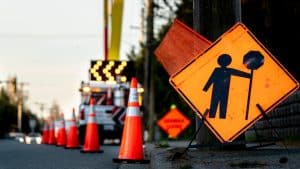Do Traffic Safety Campaigns Work?
 Have you ever come across a traffic sign that grabs your attention as you’re driving? It may be one of those blinking traffic signs that warn you in a creative way not to drink and drive or to remember to use your seat belt. As great as that sign is at entertaining you or making you think, what true effect does it have on your driving? Does the sign remind you to wear your seat belt (if you didn’t already have it on), or do you see a significant change in any other drivers’ actions after coming across the sign?
Have you ever come across a traffic sign that grabs your attention as you’re driving? It may be one of those blinking traffic signs that warn you in a creative way not to drink and drive or to remember to use your seat belt. As great as that sign is at entertaining you or making you think, what true effect does it have on your driving? Does the sign remind you to wear your seat belt (if you didn’t already have it on), or do you see a significant change in any other drivers’ actions after coming across the sign?
Federal organizations like the Department of Transportation (DOT) and the National Highway Traffic Safety Administration (NHTSA) have been interested in creating education campaigns geared toward traffic safety for decades. Some of these education campaigns include creative marketing strategies like Signal Woman, a character created through the funding from the Maryland Highway Safety Office. Even though Signal Woman has a strong presence online and in the real world, the education campaigns that she promotes are not as effective. In a 2020 ranking of traffic safety tactics, the NHTSA ranked pedestrian safety education one star out of five.
In addition to pedestrian safety education, other examples of campaigns include advertisements and videos. The DOT and NHTSA also incorporate the use of social media platforms like Twitter and Instagram to reach more people with their message in the hopes of reducing car accidents. Some states have resorted to even more creative marketing strategies. The Georgia Governor’s Office of Highway Safety, for example, funded a pedestrian fashion show labeled “Dressed To Be Seen” in 2018 before introducing the state to a slogan competition two years later.
As creative as state highway safety offices have been in promoting traffic education, enforcement, and awareness, the efficiency of these campaigns is still in question. It also does not help that the number of traffic fatalities have increased significantly in the past few years, especially in urban areas. In their traffic fatality rankings, the NHTSA noted deadly accidents have risen at the fastest rate on record, and other modes of transportation like biking and walking have become more dangerous for American residents. It seems as if these types of campaigns have become less and less useful in keeping American drivers safe on the roads.
Unique characteristics of education campaigns
Dating as far back as the 1920s, safety campaigns have been used to specifically protect children from being seriously injured or killed in the streets. Some of the earlier safety campaigns include a poster in the 1930s that graphically demonstrated the risks of drinking and driving. The poster contained an illustration of a gas pump hose, a whiskey bottle, and a skull. In 1964, the National Safety Council and the Chicago Police Department collaborated together to create a video promoting defensive driving.
One of the biggest influential moments for safety campaigns involves the use of a car seat. In 1978, for example, only 8% of drivers placed their children in car seats. Once all 50 states incorporated mandatory car seat laws by 1985, education campaigns like print advertisements and billboards helped to create a new social norm for parents. Now, 90% of drivers place their children in car seats.
Making traffic safety campaigns more effective
From these past examples, there are two takeaways that all organizations involved in traffic safety can learn in regards to education campaigns. The first is that education campaigns are more effective when they target a specific group of people. For example, the main reason why the car seat safety campaigns were so effective is because the campaigns were geared toward parents who had a particular interest in keeping their children safe.
The second takeaway is that campaigns are more effective when they share knowledge unfamiliar to the intended audience. Referring back to the car seat safety campaigns, many parents were unaware that car seats can reduce the chances of injury for children by 70%, compared to only a seat belt. However, if you compare the safety campaigns from the 1970s to the campaigns of today, many people already know that texting while driving is wrong. They know that speeding is a dangerous behavior, but still continue to speed anyway.
In addition to the lack of new information introduced through the safety campaigns, another issue is that these campaigns do not offer supportive services or consequences associated with the message. Safety campaigns are just presenting information about seat belt laws or texting while driving expecting drivers to change their habits.
The National Academies of Science, Engineering, and Medicine’s Transportation Research Board addressed this issue in a 2008 study that surveyed a variety of traffic safety research. The authors asserted that it is unlikely that individuals will want to adopt new behaviors or enhance their personal health or safety after being made aware of these behaviors.
The lesson to be learned from federal organizations and state highway traffic safety organizations is that information-only education programs are not effective. When the audience already knows that an act is illegal or that they should not be doing something, the program is unlikely to work. That means that several of the campaign tactics – signs, pamphlets, advertisements – are unlikely to create any significant changes in drivers’ behaviors.
Regardless, accidents continue to happen every single day. If you or your loved ones have been seriously injured from the negligence of another driver, you deserve to hold that driver accountable. The car accident lawyers of Merkel & Cocke are here to help you recover physically and financially as best as possible. We represent injured clients in Jackson, Clarksdale, Greenville and Oxford. We also serve clients in Tupelo and the Gulf Coast. Call us today at 662-627-9641, or complete our contact form to schedule a consultation.

After graduating from the University of Virginia Law School in 1975, Mr. Cocke and Mr. Merkel established Merkel & Cocke, P.A. in 1982. Since that time the emphasis of Mr. Cocke’s practice has progressed toward medical malpractice. At the present time his practice is exclusively devoted to handling medical negligence cases for the plaintiff, either as a result of direct contact by the client or on referral from other attorneys who are not familiar with the handling of medical negligence cases. Mr. Cocke was selected Best Lawyer of the year for 2012 and 2014 in The Memphis area in the field of Medical Malpractice and has been selected a Best Lawyer and Super Lawyer every year since 2006. Learn more about John Hartwell Cocke here.
